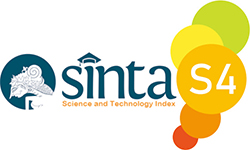Penentuan Biaya Pendidikan Siswa SD Labschool UNNES Melalui Activity Based Costing
Abstract
Abstract. SD Labschool Unnes is a laboratory school under the management of Universitas Negeri Semarang. As a school that continues to grow and strive to become a Labschool superior Labschool Unnes is required to be able to compete with other schools, especially similar private schools. Both in terms of quality, service and cost. So far, in determining the cost of education, SD Labschool Unnes still uses the traditional method. There has never been a calculation using the cost accounting method.This study aims to generate tuition fees for SD Labschool Unnes students based on calculations using the Activity Based Costing Method. Methods of data collection are done by using interviews and documentation. The data obtained were analyzed using the Activity Based Costing calculation method. The results of the calculation of the cost of education per student per class per year show the cost of education for grade 1st is IDR 7,452,548, grade 2nd is IDR 5,285,784, grade 3th IDR 5,438,426, grade 4th IDR 5,968,520, grade 5th IDR 7,251,088, grade 6th IDR 8,621,937.
Abstrak. SD Labschool Unnes merupakan sekolah laboratorium dibawah pengelolaan Universitas Negeri Semarang. Sebagai sekolah yang terus berkembang dan upaya menjadi Labschool unggulan, SD Labschool Unnes dituntut untuk mampu bersaing dengan dengan sekolah lain terutama sekolah swasta sejenis. Baik dalam hal kualitas, pelayanan maupun biaya. Selama ini dalam menentukan tarif biaya pendidikan, SD Labschool Unnes masih menggunakan metode tradisional. Belum pernah dilakukan perhitungan dengan metode akuntansi biaya. Penelitian ini bertujuan untuk menghasilkan tarif biaya pendidikan siswa SD Labschool Unnes berdasarkan perhitungan menggunakan Metode Activity Based Costing. Metode pengumpulan data dilakukan dengan menggunakan metode wawancara dan dokumentasi. Data yang diperoleh dianalisis menggunakan metode perhitungan Activity Based Costing. Hasil perhitungan biaya pendidikan per siswa per kelas per tahun menunjukkan biaya pendidikan untuk kelas 1 sebesar Rp 7.452.548, kelas 2 sebesar Rp 5.285.784, kelas 3 sebesar Rp 5.438.426, kelas 4 sebesar Rp 5.968.520, kelas 5 sebesar Rp 7.251.088, kelas 6 sebesar Rp 8.621.937.
Full Text:
PDFReferences
Alas, R., Übius, U., Lorents, P., & Matsak, E. (2017). Corporate Social Responsibility In European And Asian Countries. Jurnal Manajemen Bisnis Dan Inovasi (JMBI) UNSRAT Vol. 4 No. 1
Cropper, P. and Cook, R. (2000) ‘Developments: Activity-based costing in universities-five years on’, Public Money and Management, 20(2), pp. 61–68. doi: 10.1111/1467-9302.00213.
Duh, R. R. et al. (2009) ‘The design and implementation of activity-based costing: A case study of a Taiwanese textile company’, International Journal of Accounting & Information Management, 17(1), pp. 27–52. doi: 10.1108/18347640910967726.
Gupta, M. and Galloway, K. (2003) ‘Activity-based costing/management and its implications for operations management’, Technovation, 23(2), pp. 131–138. doi: 10.1016/S0166-4972(01)00093-1.
Hansen, D. R. and Mowen, M. M. (2009) Managerial Accounting. Akuntansi Managerial. Jakarta: Salemba Empat.
Horngren, C. T., Datar, S. M. and Foster., G. (2008) Akuntansi Biaya : Penekanan Manajerial. Jakarta: Indeks.
Karamoy, H., & Tulung, J. E. (2020). The Effect of Banking Risk on Indonesian Regional Development Bank. Banks and Bank Systems, 15(2), 130-137
Karamoy, H., & Tulung, J. E. (2020). The Effect of Financial Performance and Corporate Governance To Stock Price In Non-Bank Financial Industry. Corporate Ownership & Control, 17(2), 97-103.
Kenno, S. A. and Sainty, B. (2017) ‘Revising the budgeting model: Challenges of implementation at a university’, Journal of Applied Accounting Research, 18(4), pp. 496–510. doi: 10.1108/JAAR-04-2015-0031.
Linassi, R., Alberton, A. and Marinho, S. V. (2016) ‘Menu engineering and activity-based costing: An improved method of menu planning’, International Journal of Contemporary Hospitality Management, 28(7), pp. 1417–1440. doi: 10.1108/IJCHM-09-2014-0438.
Mitchell, M. (1996) ‘Activity-based costing in UK universities’, Public Money and Management, 16(1), pp. 51–57. doi: 10.1080/09540969609387909.
Mulyadi (2003) Activity Based Costing. Yogyakarta: UPP AMD YKPN.
Mulyadi (2006) Akuntansi Manjemen. Yogyakarta: STIE YKPN.
Pandiangan, P., & Martini, I. (2021). Digital Marketing Strategy of Property Agents in The New Normal Era. JMBI UNSRAT (Jurnal Ilmiah Manajemen Bisnis dan Inovasi Universitas Sam Ratulangi)., 7(3). doi:https://doi.org/10.35794/jmbi.v7i3.31251
Sartorius, K., Eitzen, C. and Kamala, P. (2007) ‘The design and implementation of Activity Based Costing (ABC): a South African survey’, Meditari Accountancy Research, 15(2), pp. 1–21. doi: 10.1108/10222529200700008.
Sorros, J., Karagiorgos, A. and Mpelesis, N. (2017) ‘Adoption of Activity-Based Costing: A Survey of the Education Sector of Greece’, International Advances in Economic Research, 23(3), pp. 309–320. doi: 10.1007/s11294-017-9640-1.
Toompuu, K. and Põlajeva, T. (2014) ‘Theoretical framework and an overview of the cost drivers that are applied in universities for allocating indirect costs’, Procedia - Social and Behavioral Sciences, 110, pp. 1014–1022. doi: 10.1016/j.sbspro.2013.12.948.
DOI: https://doi.org/10.35794/jmbi.v9i2.39570
Refbacks
- There are currently no refbacks.

This work is licensed under a Creative Commons Attribution-NonCommercial-ShareAlike 4.0 International License.






